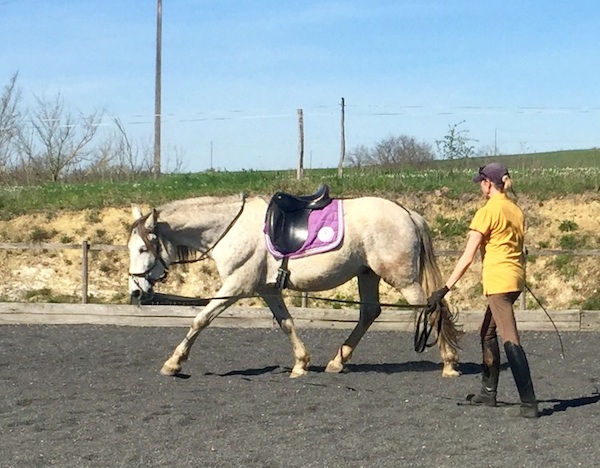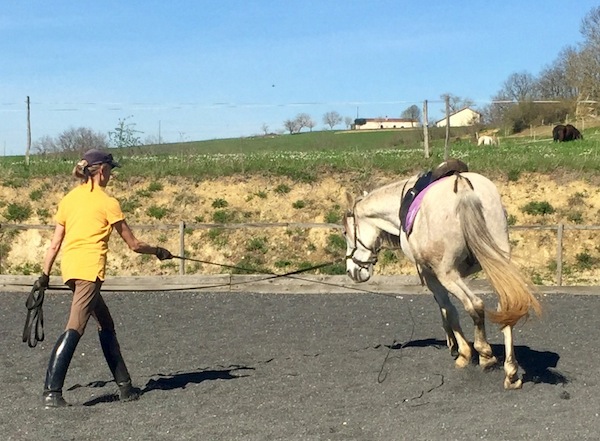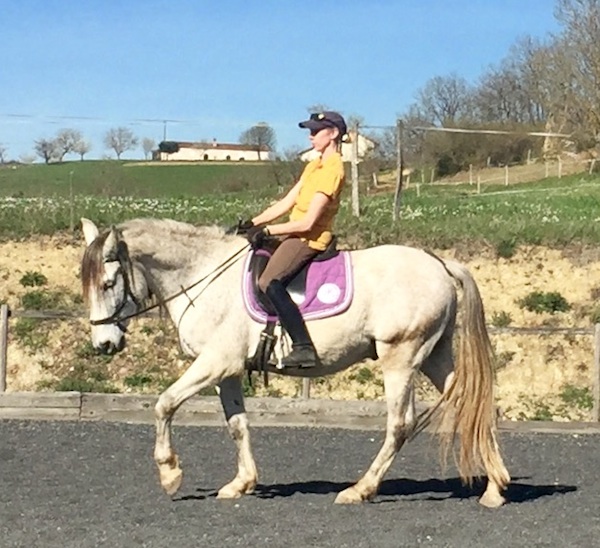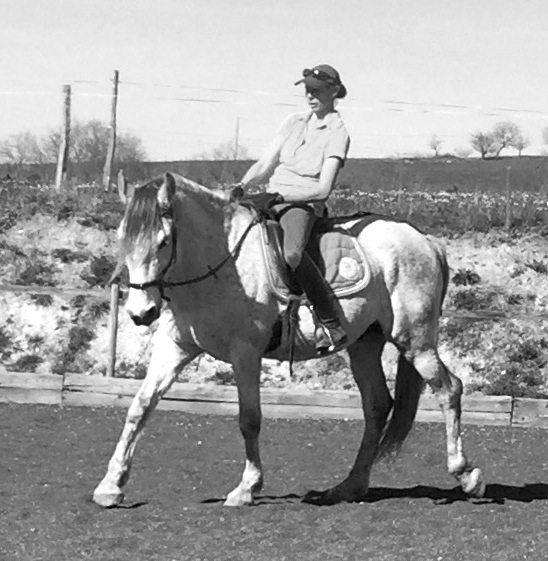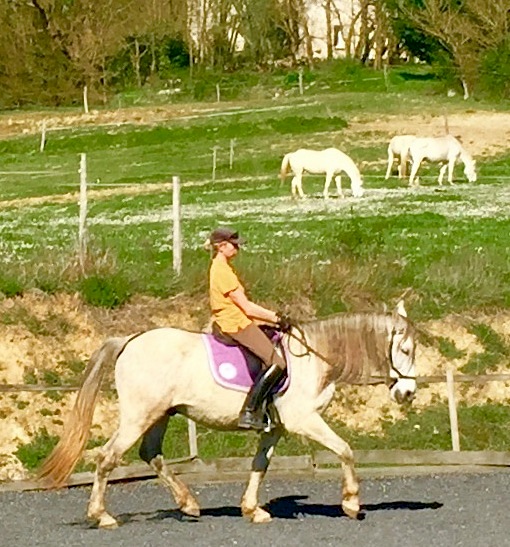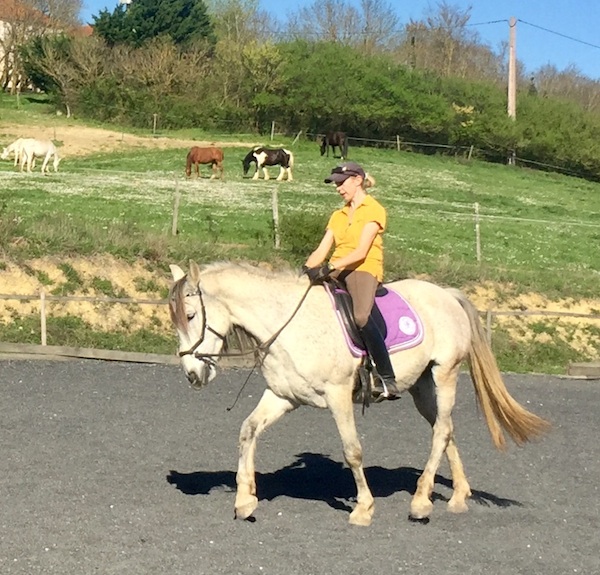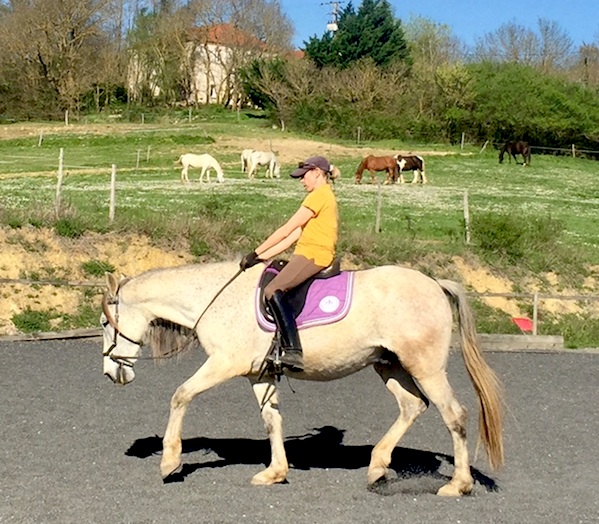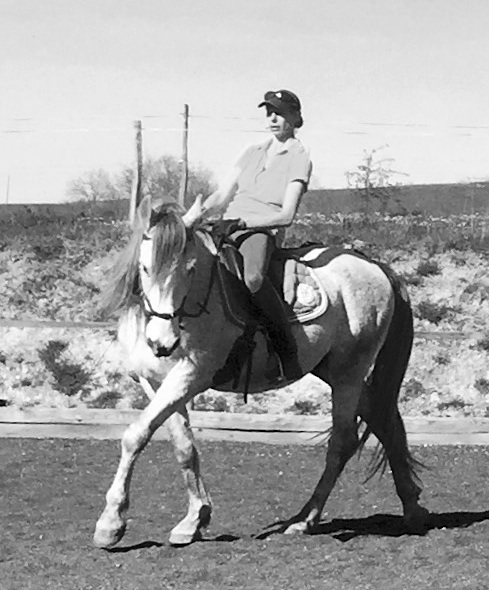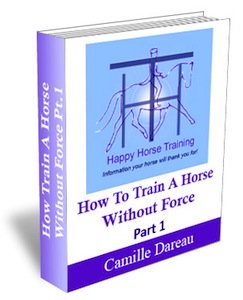| Back to Back Issues Page |
 |
|
Dancing With Boundaries April 02, 2017 |
Dancing With Boundaries
You can read a previous newsletter about Habi's process and background here: The Whole Horse newsletter: Breaking the Ice As with all traumatized horses, the challenge is to do what is required to meet their boundary without pushing through it and triggering defensive trauma responses. This is a particularly difficult line to walk with Habi, as his quietly dominant and unyielding character sets a very strong boundary that requires you to be equally confident and assertive with him to gain his trust and respect. At the same time it's vital to know when to back off and not ask to much to avoid losing his trust. The latest stage we went through in his gymnastic riding work made me think about how we know when to ask and when to back off - in a way it's the most important question there is in training a horse.
One more layer...About a month ago I decided Habi was ready to start riding work again after he had made an important emotional shift during his lunging work - he released a lot of anger that I think he had been storing deep inside for a long time. This release expressed itself as aggression towards me - several times he turned in and came at me with teeth bared or back feet kicking, and he also repeatedly bolted, threatening to run over me.It would be easy to take this behavior as a betrayal of the mutual trust I had carefully cultivated over the last year, but the truth is that none of his aggression was personal to me. It was just old history that he had to relive and let go of. The trust we built until this point didn't go away during this stage, in fact it's the very thing allowed him to express these emotions and move on from them. It was crucial that I did not meet his aggression with any anger of my own, nor any idea of punishment. It was equally important not to back down to it though - I had to remain a leader for him or the whole process would come to a halt. After this there were about three sessions where he just wanted to gallop flat out on the lunge (much to baby Licia's delight as she watched from the sidelines!). Considering how reluctant he is to go forwards he is usually, it was a dramatic shift. I stayed quiet and allowed him the freedom to express his energy as much as possible without trying to stop him or slow him down. Once this release was over he was different in the way that's characteristic of an energetic unwinding - a shift that's clear yet subtle, and permeates his whole being. You can feel that it's a permanent thing, because it's not some kind of behaviour you've imposed on the horse, it's them coming back towards their true nature. With Habi it was like a wash of tension had come away leaving him calm on a deep level. He was more willing to yield and go forward, and energetically he looked brighter and fresher. He also started being able to stretch and bend much better on his convex left rein, something that he's struggled a lot with due to a strong natural crookedness set in place by years of compensation and stiffness.
Starting to be able to stretch consistently on his challenging left rein, with very good hindleg engagement here.
...and we're ready to ride!With this new calm and gymnastic progress, I knew he was ready for me to start riding work.The first times a rode him I could really sense a lot of ideas going through his head about how he could get out of the arena and back to his friends! I knew I needed to ride him quite positively in terms of postural channeling and definitely not back off - I had to show him that the door was open for him to go truly forward with a rider on, most probably for the first time in his life. This 'open door' is not just about not holding onto him with the reins, which is of course vital, but on a deeper level it's about creating enough alignment in his body that his movement goes all the way through his spine, stimulating the longitudinal stretch, with it's characteristic dropping of the head, softening of the jaw and raising of the back. This is a wonderful thing for a horse to feel for the first time, especially one who has been utterly blocked and stifled by forceful riding in the past. I could feel how new and different it was for him, and it totally took his mind away from his thoughts of napping!
A nice moment of engagement on the left rein - it's far from consistant yet, but he's making a good start. The weakness of his postural ring is the reason for his fairly low head carriage and his his hindleg not stepping more deeply under. These are things that you have to allow to improve gradually as a function of the postural ring strengthening.
After the honeymoonAs with many new experiences in life, there's often a honeymoon period where everything's great, and then the challenges start to present themselves!Engagement is a wonderful feeling of connection and balance for horses (and riders) but it's also downright hard work to begin with! It's very demanding on the central-nervous-system which has to change its patterning and coordination, but it's also a substantial physical effort for the postural muscles.
Engaging the postural ring is hard work to begin with!
On a deeper level, engagement also creates a profound connection between horse and rider, and it's a bit like both parties have to surrender themselves to the new being that is created when two bodies become one. Horses often find this feeling of letting themselves go to the bio-mechanism of engagement disconcerting at first - they sometimes even call out to their friends for reassurance. Horses like Habi, who have lost their trust in people, will obviously find this deep connection even more challenging, and his stopping was a way of taking back control and reasserting his boundary. Once again - as with the aggression on the lunge - I had to be careful with how I addressed him presenting me with such a strong boundary. It felt like he was giving me an open invitation to force him again and confirm his previous experience of being ridden. I could feel his diaphragm braced and blocked, as if he was holding his breath. The first times he stopped like this and ignored my massaging leg aids, although it was tempting to push for more and insist he moved, instead I just stopped asking. I dropped the reins and waited, scratching his mane to help him relax. After a few minutes I felt his diaphragm soften and breath, and he walked on again of his own accord. I think my non-violent response took him by surprise, and it seemed as if he wanted to push my boundary further and seek out my limits. As soon as the work got more demanding, asking for trot for example, he started stopping again but with more determination, and for much longer periods. I kept waiting for him, showing that I was listening to him and respecting his boundary, and when he did eventually accept to go forward, I did only a small amount of work and then ended the session. There were a couple of sessions where we spent more time standing still than moving! From a conventional point of view, I was just 'letting him get away with it', and of course he was taking advantage by stopping more and more. But this way of seeing things shows ignorance of the processes involved in repairing damaged boundaries, and comes from a basic lack of faith in horses' good will towards us. If a horse trusts you, feels comfortable and happy, then they have no reason not to go forwards when you ask, as long as you're not simply asking for too much of course. So when they don't want to go, you have to listen to them and discover why. Habi was only partly stopping because he was finding the postural engagement difficult. The underlying reason was that in the past he had not been listened to or given the choice about anything he was made to do. His natural good will had been tarnished by force and dominance, and now that force was gone he had no reason to respect a rider and listen to their requests. This was an important opportunity to start undoing this pattern and show him that a rider is capable of listening
to him and giving him space.
Time To Move OnAt a certain point after these sessions of just waiting and allowing, I felt a level of relaxation in Habi, and I had an intuitive sense that he was ready for me to assert my boundary and ask him to go forwards.I knew from the same process we had gone through in the lunging work that he would need me to be very assertive in showing him I was up to being his leader, perhaps to raise my energy level and communicate my determination and conviction in him going forwards. I also knew that it was vital never to become angry, frustrated or impatient - these are not qualities of a trustworthy leader. At first I tried using my leg with strong massaging on his diaphragm, but he blocked this out. His sides have been used to stiffening against spurs, so leg aiding was not a solution at this stage. I felt like I needed something to 'jump' him out of his stuck state, and I remembered how when he had blocked like this on the lunge I had used the rubber butt (handle) of the lunge whip to bump quite firmly over his whole ribcage and back end in order to wake up the switched off nerves without causing any pain or discomfort that would trigger a stressful/trauma response. This kind of aiding is about keeping as much actual physical contact as possible instead of using threat of contact which causes much more tension in horses. Your energy state when you give aids like this makes all the difference - if you remain calm as you would when giving a massage then the horse will sense your therapeutic intention and stay relaxed, instead of feeling the stress and pressure generated by someone in a demanding or threatening state. I hadn't been riding Habi with a whip until this point, in case he had negative associations with it, but following my sense of what was right to do in that moment, I took a dressage whip and turned it round so I was holding the lash end. In combination with massaging leg aids from back to front, and maintaining my postural leverage (keeping my shoulders back, my seat tucked with engaged core, and my legs stretched back from the hips), I bounced the handle of the whip on his sides and haunches, repeating slowly enough to give him time to assimilate and respond instead of getting overwhelmed and raising his defenses even more. This was enough for him to go forwards, if reluctantly at first. He kept testing my determination for him to go forwards during the following sessions, and I responded in the same way. Then he started just going forwards normally, as if he had finally accepted me as his leader. Since then I've been able to hold the whip normally and use a gentle tap when needed without it generating any stress or tension. Thanks to Habi's acceptance to go forward we've made good progress with his straightening and postural engagement in walk and trot on both reins, although it's only the beginning of that journey.
The trot is coming more easily on his right, concave/natural bend, side at first, as is usually the case. He has nice self-carriage here, and his diagonals are not too far off parallel!
His postural weakness in this longer parabola is made clear by the non-parallel diagonals - the hindleg is not lifting as much as the foreleg - but it's early days. You can see how much I'm having to engage my core and round my own back in order to help him to do the same!
Real Progress is UnwindingYou could say the process I described is all very well, but why didn't I just nip things in the bud and insist that he went forwards when he first started stopping, in the way I did later on?The reason for this makes all the difference in the world, because giving a horse that space where you listen to them - really listen, not just go through the motions while still fitting them into your own agenda - and where you allow them to make a choice, that is what allows their pattern to unwind and their broken trust to heal. Habi was not in the same place, energetically, when he first started stopping as he was after I had shown him that I was OK with it. It might seem contradictory, but sometimes being a leader for a horse is about doing nothing, just being with them, and sometimes it's about showing them you have the courage of your convictions and that you know they're ready for the next step even though they aren't sure about it themselves. It's like
in a dance: even though there is usually one leader, each partner has to be a willing participant with the space to express themselves. Just like with riding, the leader earns the trust of their partner by always being in the right place, giving support when it's needed, but taking the pressure off when it gets too much. This makes the dance a pleasurable experience not an ordeal.
Who Needs Rules?The unpredictable nature of the unwinding process is why it's impossible to lay down rules for it, because it's about allowing yourself total freedom of what feels right to do in each moment. This includes the choice of equipment, the length and frequency of your sessions, the rate of training progress etc., etc.For example I wouldn't have anticipated using a whip with Habi, but it was exactly the tool I needed In that moment when I took it. I don't ride him with a bit at the moment, because it doesn't feel right for him just now, but one day that might change and I will use one, or maybe he will never have a bit again. It's harder to work with horses this way, rather than following a step-by-step system, because it requires you to take full responsibility for decisions, develop your conscious awareness/intuition and your ability to stay present in each moment. That entails developing your whole being in a positive way, but it's infinitely more rewarding than following some rigid system and imposing someone else's criteria on your relationship with your horse. This doesn't mean there should be no structure of principles to learn and work on though, it's how you apply them that matters. The universal nature of the biomechanics of gymnastic training means that there are certain principles that are so consistently true you could call them rules. For example, the fact that using your posture like a pillar down the inside of the bend to resist the outward rotation of the ribcage will result in transmission of the energy from the inside hind through to the inside rein contact and help the horse to soften onto the bend. But the point is that in applying this principle you are always maintaining the awareness that allows you to feel for the horse's response and validation of what you're doing. Sometimes, due to a particular horse's crookedness pattern, that feeling may tell you that in fact you need to apply more postural influence to the outside in order to achieve better alignment. If you ride this way, constantly feeling, observing, experimenting, then you will form a real understanding of what you are doing and why, and you're more likely to discover solutions to the problems you come up against.
Coming soon!I will be making my new rider coaching services available later this month, along with a fantastic offer on my introductory 'Balance Analysis' package to get your riding of to a whole new start this spring! Coaching is an exciting new tool for making serious progress in your riding and training skills, without the constraints of location and traveling. It can also give a depth of personal support that is not possible in the traditional riding lesson context. Look out for more details of BecomeOne Rider Coaching soon!
Just Click here to go to the HHT group page, and then click on the 'join group' button at the top right of the page.
Sharing the Holistic Message
If you enjoy the Happy Horse Training website, and you find the information on it useful, please help us to share it by clicking on the Facebook 'like' and 'share' buttons that are on each page (you can also share this newsletter by clicking on the symbol above). Any other way you can pass the site on to friends and colleagues, for example via discussion forums, is also greatly appreciated. You can also sign up to our RSS feed (blog) to be kept up to date with new ideas, pages and other information that we post there. Just click on the box that says 'subscribe to this site' at the left of each page. The equestrian world is one dominated by traditionalist ideas and conventions, but we would like to help inform the growing minority of horse-owners who want to make their horses happier with progressive and holistic methods.
Happy Horse Training now has over 100 pages exploring many different areas of holistic equitation. Do have a look through our site plan to find the subjects and categories that interest you.
Available from HHT:
The Gymnastic Rider eBook 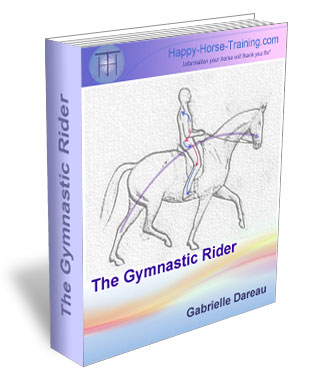 Available exclusively from HHT, a unique and comprehensive guide to practical rider biomechanics. This professionally produced eBook takes the rider through the process of developing their body in the specific way that brings the horse's movement into harmony and balance, without force and constraint.
Available exclusively from HHT, a unique and comprehensive guide to practical rider biomechanics. This professionally produced eBook takes the rider through the process of developing their body in the specific way that brings the horse's movement into harmony and balance, without force and constraint.
The information in this book, including over 55 000 words, represents what we would normally pass on in a minimum of 12 specialist lunge lessons, focusing on each part of the position and its influence on the horse, with a value of at least €450. The Gymnastic Rider is available for only €29.99. Click here for full details, and to download the 15-page introduction to the book for free.
How to Train a Horse Without Force
eBook With your purchase you will receive a free bonus supplement on Horse Trauma - cutting edge insights on this subject that up until now have mostly been applied only to human trauma. This supplement shows how to recognise, avoid and deal with horse trauma, which is much more common that we realise. These two e-books - How to Train a Horse Without Force and Horse Trauma comprise more than 75 thousand words and are richly illustrated. They are available for only 19.99 Euros (around $26). Click here for more details.
|
| Back to Back Issues Page |
